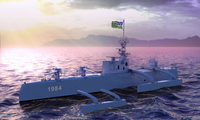An autonomous robot is a robot that acts without recourse to human control. The first autonomous robots environment were known as Elmer and Elsie, which were constructed in the late 1940s by W. Grey Walter. They were the first robots in history that were programmed to "think" the way biological brains do and meant to have free will. Elmer and Elsie were often labeled as tortoises because of how they were shaped and the manner in which they moved. They were capable of phototaxis which is the movement that occurs in response to light stimulus.
Robotic control is the system that contributes to the movement of robots. This involves the mechanical aspects and programmable systems that makes it possible to control robots. Robotics can be controlled by various means including manual, wireless, semi-autonomous, and fully autonomous.
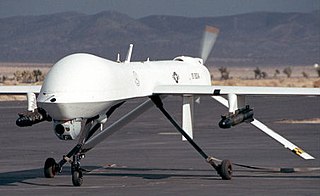
Military robots are autonomous robots or remote-controlled mobile robots designed for military applications, from transport to search & rescue and attack.
The DARPA Grand Challenge is a prize competition for American autonomous vehicles, funded by the Defense Advanced Research Projects Agency, the most prominent research organization of the United States Department of Defense. Congress has authorized DARPA to award cash prizes to further DARPA's mission to sponsor revolutionary, high-payoff research that bridges the gap between fundamental discoveries and military use. The initial DARPA Grand Challenge in 2004 was created to spur the development of technologies needed to create the first fully autonomous ground vehicles capable of completing a substantial off-road course within a limited time. The third event, the DARPA Urban Challenge in 2007, extended the initial Challenge to autonomous operation in a mock urban environment. The 2012 DARPA Robotics Challenge, focused on autonomous emergency-maintenance robots, and new Challenges are still being conceived. The DARPA Subterranean Challenge was tasked with building robotic teams to autonomously map, navigate, and search subterranean environments. Such teams could be useful in exploring hazardous areas and in search and rescue.
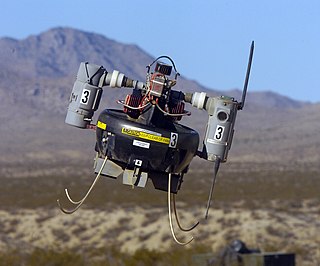
A micro air vehicle (MAV), or micro aerial vehicle, is a class of man-portable miniature UAVs whose size enables them to be used in low-altitude, close-in support operations. Modern MAVs can be as small as 5 centimeters - compare Nano Air Vehicle. Development is driven by commercial, research, government, and military organizations; with insect-sized aircraft reportedly expected in the future. The small craft allow remote observation of hazardous environments or of areas inaccessible to ground vehicles. Hobbyists have designed MAVs for applications such as aerial robotics contests and aerial photography. MAVs can offer autonomous modes of flight.
The Centennial Challenges are NASA space competition inducement prize contests for non-government-funded technological achievements by American teams.

Swarm robotics is an approach to the coordination of multiple robots as a system which consist of large numbers of mostly simple physical robots. ″In a robot swarm, the collective behavior of the robots results from local interactions between the robots and between the robots and the environment in which they act.″ It is supposed that a desired collective behavior emerges from the interactions between the robots and interactions of robots with the environment. This approach emerged on the field of artificial swarm intelligence, as well as the biological studies of insects, ants and other fields in nature, where swarm behaviour occurs.

An unmanned ground vehicle (UGV) is a vehicle that operates while in contact with the ground and without an onboard human presence. UGVs can be used for many applications where it may be inconvenient, dangerous, or impossible to have a human operator present. Generally, the vehicle will have a set of sensors to observe the environment, and will either autonomously make decisions about its behavior or pass the information to a human operator at a different location who will control the vehicle through teleoperation.

Robert C. Michelson is an American engineer and academic who invented the entomopter, a biologically inspired flapping-winged aerial robot, and who established the International Aerial Robotics Competition. Michelson's career began at the U.S. Naval Research Laboratory. He later became a member of the research faculty at the Georgia Institute of Technology. He is the author of three U.S. patents and over 100 journal papers, book chapters and reports. Michelson is the recipient of the 1998 AUVSI Pioneer Award and the 2001 Pirelli Award for the diffusion of scientific culture as well as the first Top Pirelli Prize.
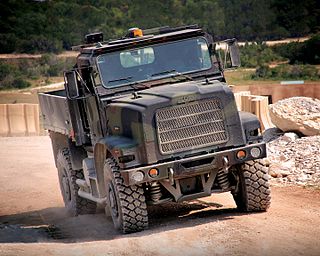
TerraMax is the trademark for autonomous/unmanned ground vehicle technology developed by Oshkosh Defense. Primary military uses for the technology are seen as reconnaissance missions and freight transport in high-risk areas so freeing soldiers from possible attacks, ambushes or the threat of mines and IEDs. The technology could also be used in civilian settings, such as autonomous snow clearing at airports.
Burgundy Farm Country Day School is an independent school on a 25-acre (100,000 m2) campus in the Rose Hill census-designated place of Fairfax County, Virginia, with an Alexandria postal address, and 611 acres (2.47 km2) in West Virginia. It serves students in grades Junior Kindergarten through Eighth Grade.
Autonomous logistics describes systems that provide unmanned, autonomous transfer of equipment, baggage, people, information or resources from point-to-point with minimal human intervention. Autonomous logistics is a new area being researched and currently there are few papers on the topic, with even fewer systems developed or deployed. With web enabled cloud software there are companies focused on developing and deploying such systems which will begin coming online in 2018.
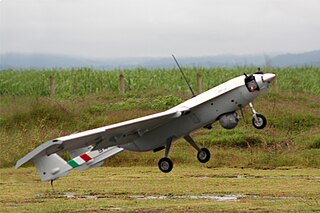
The S4 Ehécatl is an unmanned aerial vehicle developed and manufactured by Hydra Technologies of Mexico which, except for its infrared thermal sensor system, is the first of its type to be completely designed and manufactured in Mexico. It is named after Ehecatl, the Aztec god of the wind.
The Association for Uncrewed Vehicle Systems International, also known as AUVSI, is an international nonprofit organization dedicated to advancing the unmanned systems and robotics industry through communication, education, and leadership.
There are a number of competitions and prizes to promote research in artificial intelligence.

The Indian Underwater Robotics Society or IURS is India's first and only non-profit research organisation NGO for the advancement of low-cost robotics and intelligent systems research in developing countries. IURS also imparts education in it is focus areas to improve understanding of and representation in intelligent systems research within developing countries.

The Boeing Phantom Ray is an American demonstration stealth unmanned combat air vehicle (UCAV) developed by Boeing using company funds. The autonomous Phantom Ray is a flying wing around the size of a conventional fighter jet, and first flew in April 2011. It will conduct a program of test flights involving surveillance, ground attack and autonomous aerial refueling missions. The developers say it can carry 4,500 pounds of payload.
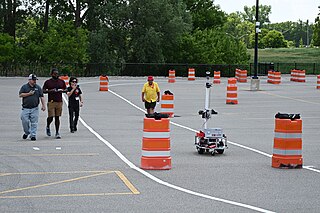
The Intelligent Ground Vehicle Competition (IGVC) is an annual international robotics competition for teams of undergraduate and graduate students. Teams may compete in either the AutoNav or Self Drive challenges. The competition is well suited to senior design capstone courses as well as extracurricular design projects.
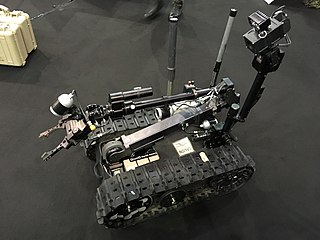
UGV Interoperability Profile (UGV IOP), Robotics and Autonomous Systems – Ground IOP (RAS-G IOP) or simply IOP was originally an initiative started by the United States Department of Defense (DoD) to organize and maintain open architecture interoperability standards for Unmanned Ground Vehicles (UGV). A primary goal of this initiative is to leverage existing and emerging standards within the Unmanned Vehicle (UxV) community such as the Society of Automotive Engineers (SAE) AS-4 Joint Architecture for Unmanned Systems (JAUS) standard and the Army Unmanned Aircraft Systems (UAS) Project Office IOPs.
Gazebo is an open-source 2D/3D robotics simulator that began development in 2002. In 2017, development forked into two versions, known as "Gazebo", the original monolithic architecture, and "Ignition", which had moved to becoming a modernized collection of loosely coupled libraries. Following a trademark obstacle in 2022 regarding their use of the name "Ignition", Open Robotics took the opportunity to switch the version names, dubbing the original fork "Gazebo Classic" and the new, modern fork "Gazebo".







